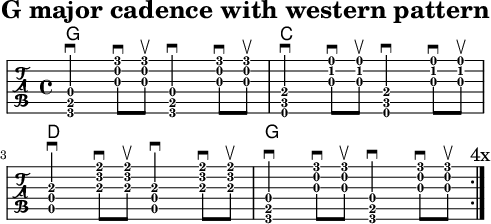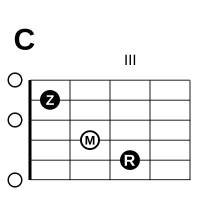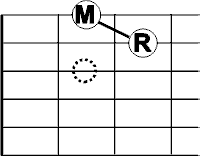Guitar/Chord changes G-C-D
This page is currently being translated from Germans Wikibooks into English. • Expect some errors and inconsistencies. •Images has to be repainted. The German fingering ZMRK = imrp (Z = Index, K = small Finger = pinKy •Some German words in pictures has to be translated. • Assisted the translator because he is not a native speaker. Feel free to correct mistakes and style. • The Wikitorians among you may help me with the peculiarities of English Wikibooks. (how do you handle things, what are your preferd templates...). •delete {:Guitar/under construction - in translation}if you think the translation is largely error-free and good enough.• Be patient. The translation of the finished German lesson (links in the navigation) will take time. |
Original page translated by Google
C major chord or G major cadence
[edit | edit source]All you need is a new chord and you're already in a new key. This time it's the key of G major. We're leaving the A major chord behind. A major is not part of the key of G major and only occurs there as an exception at most. On the other hand, the chord C major regularly belongs to the key of G major. The three major chords of the key of G major are G C and D.
Comparison using the circle of fifths[1]
In the new key of G major, G is now the calm tonic, C is the connecting subdominant and D is the tense dominant. In the key of G major, the dominant often appears as D7, although we can simply ignore the 7 at the beginning.
Go through
again and replace the tonic D major with the new tonic G major. The old subdominant G is replaced by C and the dominant A by D.
This is also how you proceed if you want to transpose a song into a higher or lower key.
From G major to C major and back again
[edit | edit source]Even if it is not yet necessary for the current playing, I would like to point out the "black" notes. These notes have the same name as the chord. They are the basic notes of the chord. Later on, we will use these notes for plucking and for special touch exercises in which the bass note is to be emphasized. For the moment, however, you don't need to concern yourself with this. The Roman numeral 3 (III) only refers to the 3rd fret. Since people like to work with numbers in chords, you can avoid some confusion by indicating the frets with Roman numerals.
For me C major is somewhere in the 'c'enter.
It is best to practice changing the chords several times in a row.
- Audio example
From C to D and back
[edit | edit source]You should also practice the following grip change a few times in isolation. But in principle you shouldn't have any difficulties with it.
Audio sample
[edit | edit source]
This is what the western beat looks like in a tablature. How this is read will be covered at a later date.
But pay attention to the notes. Every note that has only one beat (i.e. if you count a number without a following "and") also has only one note stem. There is no additional flag or bar. If a double beat is played down and up, the note stems are usually connected by a bar. The first note is usually the downbeat, and the second, which is connected to the bar, is the upbeat, or the "and".
What is a major cadence?
[edit | edit source]The G major cadence G C D G is a special chord progression. So tonic, subdominant, dominant, tonic. Play it once. The chords have a certain auditory impression and therefore a certain function: G = start, C = continuation, D = tension, G = resolution.
This chord sequence is called the G major cadence and helps your ear to find its way around the key.
Names of the strings
[edit | edit source]If you don't already know or haven't read it somewhere else:
- To memorize the order of the strings from top to bottom, remember either the following saying:
|
Elephants And Donkeys Grow Big Ears |
- ↑ The circle of fifths is a useful "tool" for memorizing chords that usually belong together.
In addition, a lot of information can be derived much more easily from the circle of fifths (because the notes that belong together are usually next to each other) than by laboriously counting them along the (chromatic) scale. Nevertheless, it does not have to be understood or learned at this point. However, since the campfire, folk, rock and later the rock ballad diploma are very closely based on the circle of fifths in their structure, hopefully a "hunch" will soon arise intuitively. The actual system behind the whole thing can then be supplemented later with the correct facts.
The circle of fifths is more important here for the (voluntary) guitar teacher who is supposed to internalize the concept of "diplomas". For the students, fragments of the circle of fifths may be introduced into guitar lessons through marginal notes such as "E major has - (Goes down and ends) - four sharps, D major has - (Goes down) - two sharps" and only gradually make sense to the student.
At this point in time, the circle of fifths functions more like an Advent calendar, where each new chord represents something like a new door in the circle of fifths calendar.


















